Topics
Category
Era
Mesabi Iron Range
The Mesabi Iron Range wasn’t the first iron range to be mined in Minnesota, but it has arguably been the most prolific. Since the 1890s, the Mesabi has produced iron ore that boosted the national economy, contributed to the Allied victory in World War II, and cultivated a multiethnic regional culture in northeast Minnesota.
The Mesabi Iron Range’s history as a mining district begins well before ore was unearthed. More than two billion years ago, an era of mountain building known as the Algoman orogeny occurred. High mountains were built in northern Minnesota and, later, a large shallow sea covered much of the upper midwest. This waterbody eroded the iron-rich rock of the mountain range, and the resulting sediment settled to the bottom of the sea. As the sea dried up and oxygen was produced in the atmosphere, the iron sediment was compacted by layers of silt that formed iron and taconite deposits throughout the Mesabi. The iron formation is called the Biwabik Iron Formation, and the long ridge is the Giants Range Batholith, which is all that is left of the high peaks of the Algoman Mountains. The term Mesabi comes from the Ojibwe name for the Giants Range Batholith: Misaabe Wajiw, or Big Man Mountain.
While it is documented that the Ojibwe were aware of iron ore on the nearby Vermilion Range, it is difficult to determine if they knew of the more obscured iron deposits on the Mesabi Range. Nevertheless, the Misaabe Wajiw is an important place for the Ojibwe, as the long ridge is said to be the body of a sleeping giant that forms part of a Thunderbird’s tail. The Thunderbird (binesi) is regarded as one of the most powerful spiritual beings of the Ojibwe.
The Mesabi Range was visited by Europeans and white Americans well before it was found to be one of the world’s largest iron ore deposits. Although they noted the hills of the Mesabi as early as 1810, it wasn’t until 1866 that Henry Eames and Christian Wieland of Ontonagon, Michigan, recognized the presence of iron ore. Wieland, optimistic about what he observed, helped organize the Ontonagon Syndicate to mine the area. However, the syndicate failed to materialize and produce any ore.
Even though Eames and Wieland found that the Mesabi Range had ore, few prospectors pursued it. The ore on the Vermilion Iron Range just to the north of the Mesabi was more accessible. However, the Merritt family from Duluth spent countless hours prospecting on the Mesabi. Their efforts paid off in 1890 when they encountered a large hematite ore deposit near current-day Mountain Iron. Soon after, the Merritt family began mining, and the Mesabi Range was opened for operations.
Since the Mesabi Range was so remote, heavy investment was necessary to transport the ore to steel-processing facilities. The Merritt family understood this challenge, so they formed the Duluth, Missabe and Northern Railroad (DMNR) in 1891 (later part of the Duluth, Missabe and Iron Range Railway). While this facilitated the Merritts’ first successful shipment of ore, in 1892, it was also the family’s financial undoing. Soon after the DMNR was formed, other railroads were built by competitors. Because they didn’t have the capital to improve the DMNR, the Merritt family sought investment from other sources. After many complicated financial transactions, the DMNR and the Merritt mines were consolidated into one company managed by power broker John D. Rockefeller. The Merritt family was pushed out of Minnesota’s mining industry in 1894.
Rockefeller didn’t control the Mesabi without competition, though. Because Rockefeller didn’t own steel mills but financier Andrew Carnegie did, Rockefeller would have to sell his ore to Carnegie at some point in production. Also competing with Rockefeller and Carnegie, industrialist Henry Oliver of the Oliver Iron Mining Company controlled multiple mines on valuable deposits. To maximize everyone’s profits, they made a deal: Oliver would mine the ore, Rockefeller would transport it via railroad to the ore docks, and Carnegie would ship it to the steel mills. This agreement was eventually formalized into the world’s first billion dollar corporation, United States Steel.
Developments on the early Mesabi Iron Range shaped its cultural legacy. Two early strikes—in 1907 and 1916—catalyzed a long heritage of organized labor. The 1907 strikers were generally unsuccessful, but the 1916 strikers received some raised wages and improved working conditions. In the modern taconite industry, all but one of the operating mines are union-based. Immigration, too, has played a major role on the Mesabi Range. Mining jobs attracted migrants from different parts of the United States and Scandinavia, but during and after the 1907 strike, Eastern and Southern European immigrants arrived to work in the mines—some as “scabs” to replace striking miners. The multiethnic character of the region is still visible, especially in cuisine. Dishes like Cornish pasties, Italian porketta, and Slovenian potica are served in Iron Range restaurants and are commonly found in family cookbooks.
National industrial developments and World War II assured that there was demand for Minnesota’s ore. However, after the war, reserves of natural ore were mostly depleted. Faced with the possibility of a total industrial decline in the region, scientists and engineers—especially Dr. Edward W. Davis of the University of Minnesota—began developing methods to mine and process taconite, a low-grade iron ore that was plentiful throughout the Range. However, since it was weaker than natural ore, it required much more processing, which made it more costly to produce. To remedy this, Davis and Iron Range lawmakers sought to change the way taconite mines were taxed. This effort was successful, and the Taconite Amendment of 1964 passed a statewide referendum with 86 percent of Minnesota voters approving the plan.
The first taconite plant was Reserve Mining Company in Babbitt, soon followed by Erie Mining Company in Hoyt Lakes. Both Babbitt and Hoyt Lakes were built for their respective taconite facilities as full-service company towns with modern amenities developed out of dense forest. After the Taconite Amendment passed, other mining companies invested in taconite production plants and opened facilities, including Eveleth Taconite (EVTAC) in 1964, and both Minntac and Butler Taconite in 1967. The massive investments pumped into these plants signaled a transition in the Mesabi Range’s primary export that still allowed the region to retain its mining heritage.
The steel industry faced global challenges in the 1980s, which led to layoffs, idling, and automation on the Mesabi. Of the taconite mines that were in operation at the Iron Range’s peak, as of 2020, two have permanently closed and all have been idled at various points ever since. The taconite mines employ fewer people than they did at peak operations, which has had major effects on the communities and schools throughout the region. In 2020, the Virginia and Eveleth-Gilbert school districts voted to consolidate, which had already occurred in many other Iron Range school districts, but Virginia and Eveleth-Gilbert were two of the Iron Range’s largest school districts before consolidation plans were proposed.
Even with school consolidation and diminishing populations, the Mesabi Iron Range has continued to mine taconite, and copper-nickel mining may start in the near future. While the Range is still enduring a long transformation, the mining industry has left an indelible mark on the region’s economy, landscape, and regional culture.
Bibliography
Bois Forte Band of Chippewa Indians, Grand Portage Band of Lake Superior Chippewa, Fond du Lac Band of Lake Superior Chippewa, Bad River Band of Lake Superior Chippewa Indians, Landscape Research LLC, and Barr Engineering. “NorthMet Project Cultural Landscape Study.” September 15, 2012. https://www.leg.state.mn.us/docs/2015/other/150681/PFEISref_2/Zellie%202012.pdf
Carlson, Christine. “Posey Family.” Nahgahchiwanong Dibahjimowinnan, June 12, 2012. https://cms3.revize.com/revize/fonddulac/Documents/%20Community/Media/Fdl%20Newspaper/June12.pdf
Chester, Albert Huntington. Explorations of the Iron Regions of Northern Minnesota During the Years 1875 and 1880. Typescript. 1902. Available at the Minnesota Historical Society library as TN403.M6 C44 1902.
Drier, Roy Ward, and Octave Joseph Du Temple. Prehistoric Copper Mining in the Lake Superior Region: A Collection of Reference Articles. Calumet, MI: N.p., 1961.
Eames, Henry H. Geological Reconnoissance [sic] of the Northern, Middle, and Other Counties of Minnesota. St. Paul: Pioneer, 1866.
——— . Report of the State Geologist, Henry H. Eames, on the Metalliferous Region Bordering on Lake Superior. St. Paul: F. Driscoll, 1866.
Lamppa, Marvin G. Minnesota’s Iron Country: Rich Ore, Rich Lives. Duluth: Lake Superior Port Cities Press, 2004.
La Vérendrye, Pierre Gaultier de Varennes de. Journals and Letters of Pierre Gaultier de Varennes de La Vérendrye and His Sons: With Correspondence Between the Governors of Canada and the French Court, Touching the Search for the Western Sea. Toronto: Champlain Society, 1927.
Leith, C. K. The Mesabi Iron-Bearing District of Minnesota. Washington: United States Geological Survey, 1903.
Manuel, Jeffrey T. Taconite Dreams: the Struggle to Sustain Mining on Minnesota’s Iron Range, 1915–2000. Minneapolis: University of Minnesota Press, 2015.
Upham, Warren. Minnesota Place Names: A Geographical Encyclopedia. Third edition. St. Paul: Minnesota Historical Society Press, 2001.
Walker, David A. Iron Frontier: the Discovery and Early Development of Minnesota’s Three Ranges. St. Paul: Minnesota Historical Society Press, 1979.
Related Resources
Primary
Davis, E. W. Pioneering With Taconite. St. Paul: Minnesota Historical Society Press, 1964.
P1058, Boxes 1 and 4
Edward W. Davis papers, 1883–1973
Manuscripts Collection, Minnesota Historical Society, St. Paul
http://www2.mnhs.org/library/findaids/p1058.xml
Description: A collection of E. W. Davis’ correspondence, reports, research, technical reports, and photographs related to his research performed at the University of Minnesota’s Mines Experiment Station and Mesabi Iron Company.
6F G4141.P3 1946 .S54
Duluth, Missabe, and Iron Range Railway map
Maps Collection, Minnesota Historical Society, St. Paul
Description: Duluth Missabe and Iron Range Railway, Missabe and Iron Range Divisions, shipping points, stations, spurs, and mileage, created by F. L. Sherwin, 1946.
Duluth, Missabe, and Iron Range Railway. The Missabe Story: 1892–1967. Duluth: Duluth, Missabe, and Iron Range Railway, [1967?].
Edith Koivisto papers, 1904–1975
Manuscripts Collection, Immigration History Research Center, Minneapolis
http://ihrc.umn.edu/research/vitrage/all/ko/ihrc1233.html
Description: Diaries and personal papers of a Finnish immigrant from Hibbing.
“Jenson v. Eveleth Taconite Co., 824 F. Supp. 847 (D. Minn. 1993).” Justia.
https://law.justia.com/cases/federal/district-courts/FSupp/824/847/1460561/
Oliver Iron Mining Division. Jâwendâgosiwin (Opportunity). Duluth: United States Steel Corporation, 1956.
KFM5803 1964
Pamphlets Relating to 1964 Taconite Amendment to the Minnesota State Constitution, 1964
Pamphlets Collection, Minnesota Historical Society, St. Paul
Description: Pamphlets promoting the 1964 Taconite Amendment and outlining questions that voters might have about the proposal.
Pamphlets Relating to Iron Ore Deposits and Iron Mining in Minnesota
Pamphlets Collection, Minnesota Historical Society, St. Paul
Description: Pamphlets related to the geology, geography, extraction, and transportation of iron ore.
Pamphlets Relating to Iron Ore and Taconite Processing
Pamphlets Collection, Minnesota Historical Society, St. Paul
Description: Pamphlets related to the processing of taconite and iron ore. Produced by mining companies like US Steel, Reserve Mining Company, and Erie Mining Company.
P753
Oliver Iron Mining Company records, 1901–1930
Manuscripts Collection, Minnesota Historical Society, St. Paul
Description: Files and correspondence of the largest mining company on the Iron Range; includes information on immigrant workers, churches, and Americanization programs.
Secondary
Alanen, Arnold R. "Early Labor Strife on Minnesota's Mining Frontier, 1882–1906." Minnesota History 52, no. 7 (Fall 1991): 246–263.
http://collections.mnhs.org/MNHistoryMagazine/articles/52/v52i07p246-263.pdf
Betten, Neil. "Strike on the Mesabi—1907." Minnesota History 40, no. 7 (Fall 1967): 340–347.
http://collections.mnhs.org/MNHistoryMagazine/articles/40/v40i07p340-347.pdf
Bingham, Clara, and Laura Leedy Gansler. Class Action: The Landmark Case that Changed Sexual Harassment Law. New York: Anchor Books, 2003.
Eleff, Robert M. “The 1916 Minnesota Miners’ Strike Against U.S. Steel.” Minnesota History 51, no. 2 (Summer 1988): 63–74.
http://collections.mnhs.org/MNHistoryMagazine/articles/51/v51i02p063-074.pdf
de Kruif, Paul. Seven Iron Men: The Merritts and the Discovery of the Mesabi Range. Minneapolis: University of Minnesota Press, 2007.
Holmquist, June Drenning, ed. They Chose Minnesota: A Survey of the State’s Ethnic Groups. St. Paul: Minnesota Historical Society Press, 1981.
Torreano, Peter F. Mesabi Miracle: The 100–Year History of the Pillsbury–Bennett–Longyear Association. Hibbing, MN: Sargent Land Company, 1991.
Web
Iron Range Historical Society.
https://www.ironrangehistoricalsociety.org
Minnesota Discovery Center.
https://www.mndiscoverycenter.com
Minnesota Historical Society. Iron Range Miners’ Strikes of 1907 & 1916.
https://libguides.mnhs.org/irmstrike
Minnesota Historical Society. Taconite Mining: Technology, Taxes, & Tailings.
https://libguides.mnhs.org/taconite
Related Images
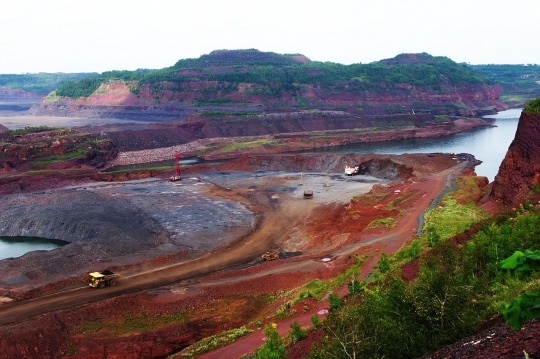
Hull-Rust-Mahoning open pit mine
Holding Location
Articles
More Information
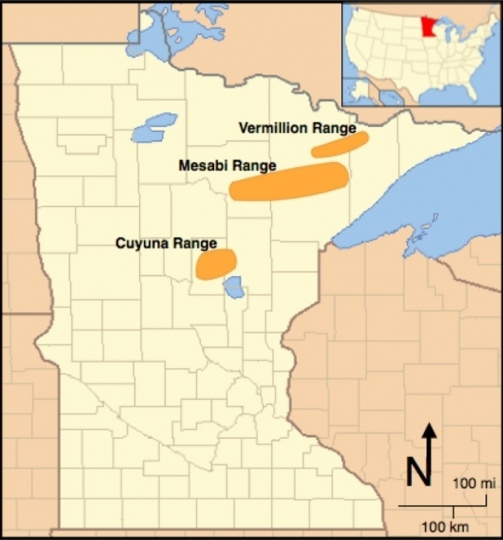
Map of Iron Ranges in Minnesota
All rights reserved
Holding Location
Articles
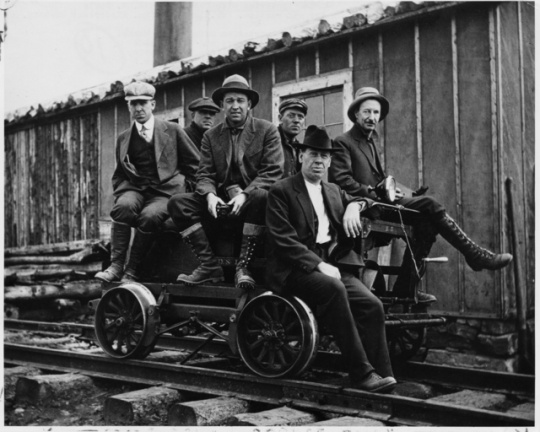
Taconite prospectors at Sulphur Camp
Holding Location
More Information
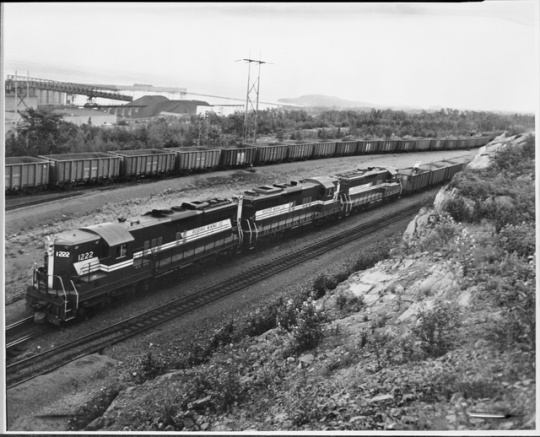
First train of taconite to Silver Bay
Holding Location
More Information
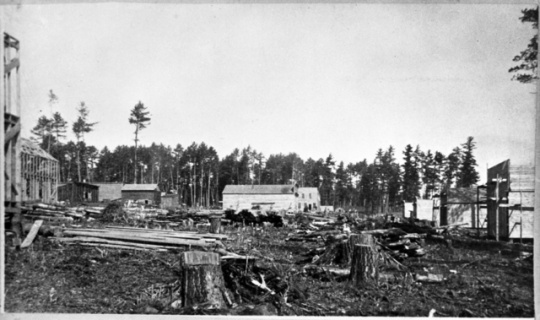
Mining townsite near Biwabik
Holding Location
More Information
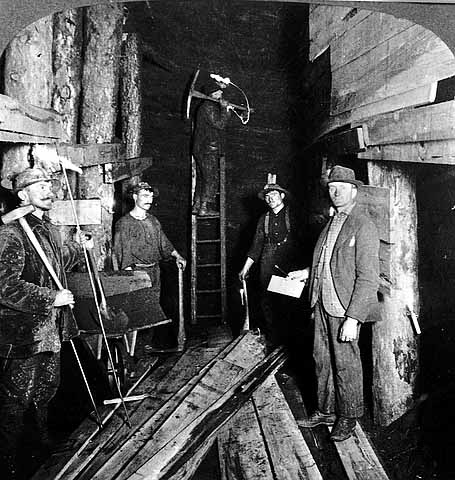
Underground mining on the Mesabi Range
Holding Location
More Information
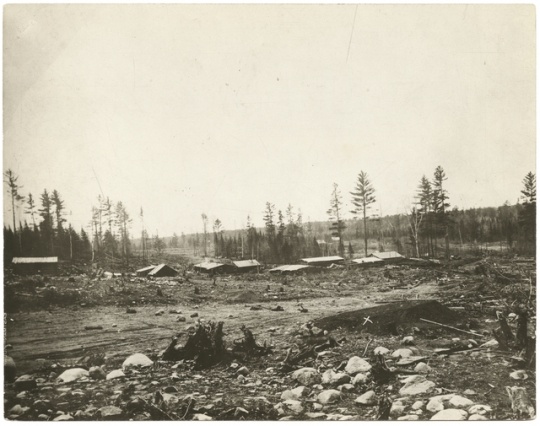
First mine on the Mesabi Range
Holding Location
Articles
More Information
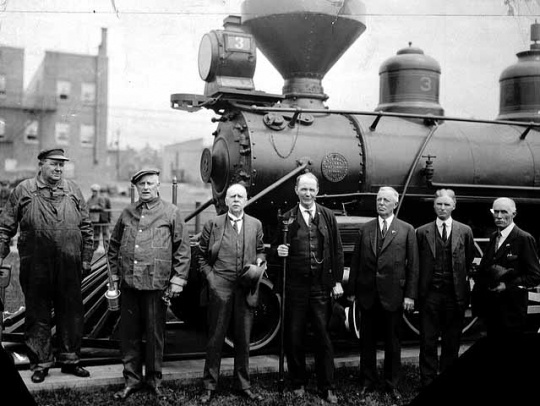
Iron-ore locomotive
Holding Location
Articles
More Information
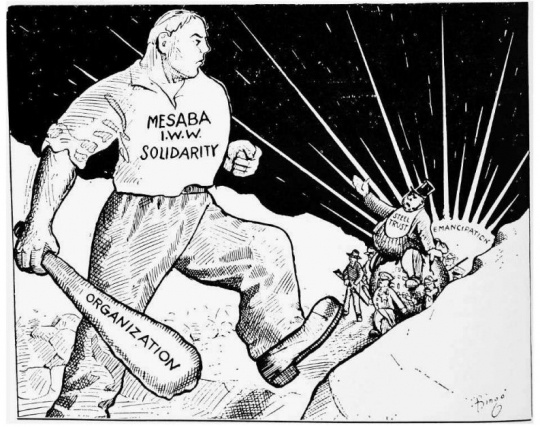
Pro-I.W.W. cartoon
Pro-I.W.W. cartoon printed in the newspaper Solidarity on July 1, 1916. Cartoon is from Betten, Neil. “Riot, Revolution, Repression in the Iron Range Strike of 1916.” Minnesota History 51, no. 2 (1988): 63–74.
Public domain
Holding Location
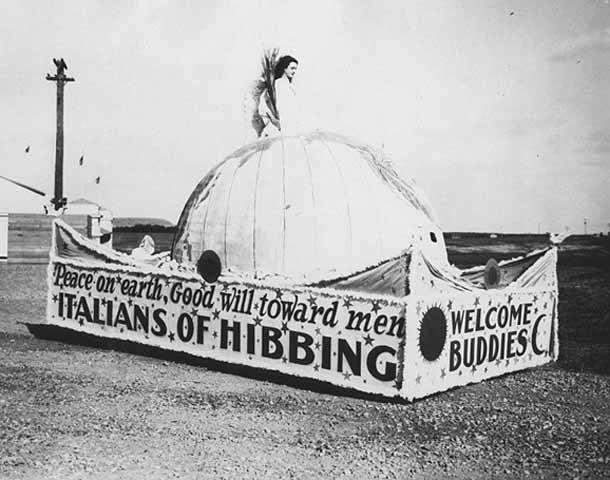
Sons of Italy Fourth of July float
Holding Location
Articles
More Information
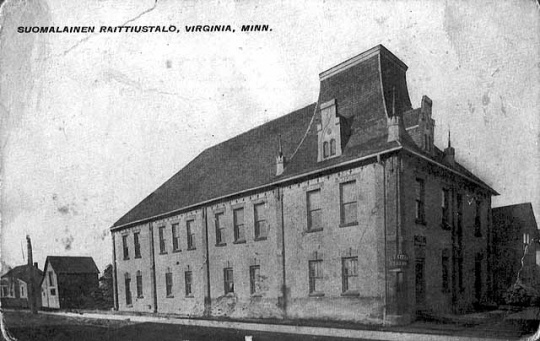
Suomalainen Raittiustalo, Virginia
Public domain
Holding Location
More Information
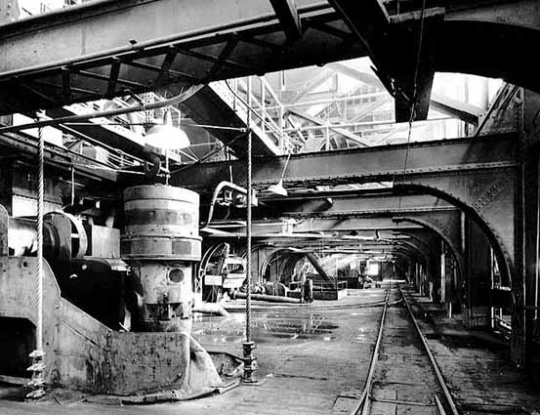
Trout Lake Concentrator
Holding Location
Articles
More Information
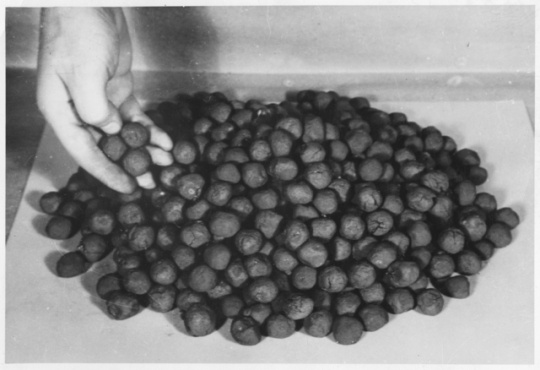
Taconite pellets
Holding Location
Articles
More Information
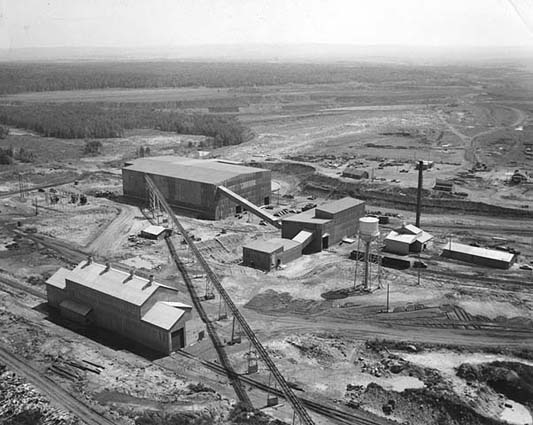
Pilotac, an experimental taconite-concentrating plant
Public domain
Holding Location
More Information
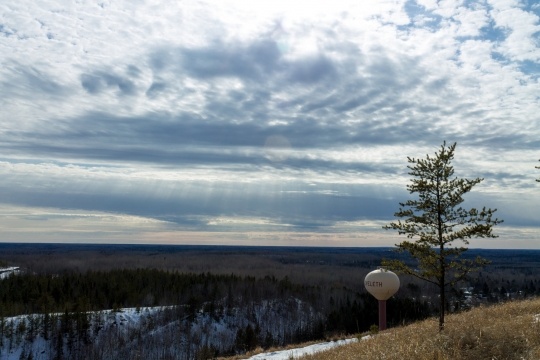
Bird's-eye view of Eveleth
A view overlooking Eveleth and the Mesabi Iron Range. Photograph by Flickr user Peng, March 11, 2015 (CC BY-NC 2.0).
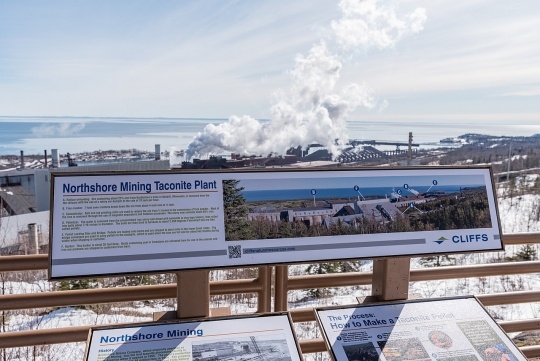
Northshore Mining Taconite Plant in Silver Bay
Holding Location
Articles
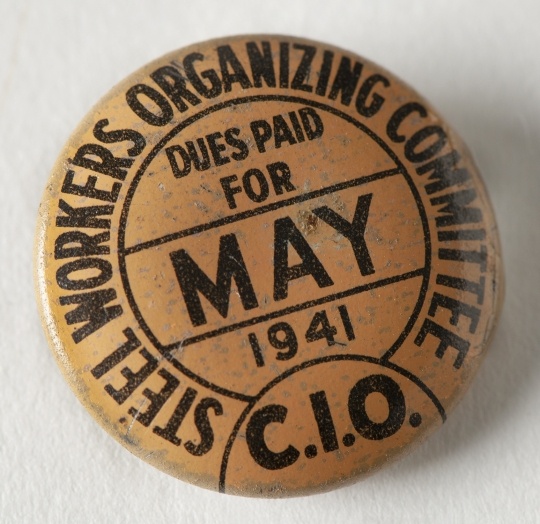
Steel Workers Organizing Committee button
All rights reserved
Holding Location
Articles
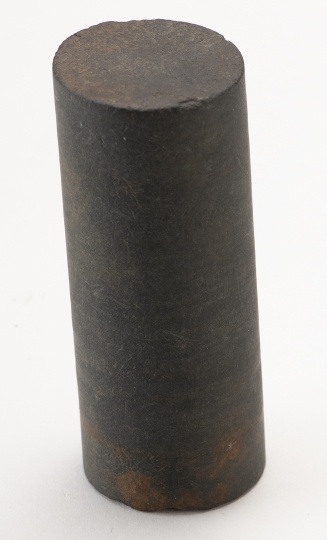
Drill core
All rights reserved
Holding Location
Articles
Related Articles
Turning Point
On November 16, 1890, a large deposit of soft hematite ore is found in Mountain Iron by Leonidas Merritt and J. A. Nichols. This deposit catalyzes an era of natural iron ore mining lasting over fifty years, which allowed for the development of unique communities along the long ridge known as Misaabe Wajiw, the Big Man Mountain, and the Mesabi Iron Range.Joseph Nicollet maps the Upper Mississippi River basin based on his expeditions through the region. His map features the “Missabay Heights,” a ridge from the Mississippi River at Grand Rapids to Thunder Bay, Canada.
Chronology
1841
1866
1875
1890
1901
1907
1909
1916
1956
1964
1972
1986
1988
2001
2019
Bibliography
Bois Forte Band of Chippewa Indians, Grand Portage Band of Lake Superior Chippewa, Fond du Lac Band of Lake Superior Chippewa, Bad River Band of Lake Superior Chippewa Indians, Landscape Research LLC, and Barr Engineering. “NorthMet Project Cultural Landscape Study.” September 15, 2012. https://www.leg.state.mn.us/docs/2015/other/150681/PFEISref_2/Zellie%202012.pdf
Carlson, Christine. “Posey Family.” Nahgahchiwanong Dibahjimowinnan, June 12, 2012. https://cms3.revize.com/revize/fonddulac/Documents/%20Community/Media/Fdl%20Newspaper/June12.pdf
Chester, Albert Huntington. Explorations of the Iron Regions of Northern Minnesota During the Years 1875 and 1880. Typescript. 1902. Available at the Minnesota Historical Society library as TN403.M6 C44 1902.
Drier, Roy Ward, and Octave Joseph Du Temple. Prehistoric Copper Mining in the Lake Superior Region: A Collection of Reference Articles. Calumet, MI: N.p., 1961.
Eames, Henry H. Geological Reconnoissance [sic] of the Northern, Middle, and Other Counties of Minnesota. St. Paul: Pioneer, 1866.
——— . Report of the State Geologist, Henry H. Eames, on the Metalliferous Region Bordering on Lake Superior. St. Paul: F. Driscoll, 1866.
Lamppa, Marvin G. Minnesota’s Iron Country: Rich Ore, Rich Lives. Duluth: Lake Superior Port Cities Press, 2004.
La Vérendrye, Pierre Gaultier de Varennes de. Journals and Letters of Pierre Gaultier de Varennes de La Vérendrye and His Sons: With Correspondence Between the Governors of Canada and the French Court, Touching the Search for the Western Sea. Toronto: Champlain Society, 1927.
Leith, C. K. The Mesabi Iron-Bearing District of Minnesota. Washington: United States Geological Survey, 1903.
Manuel, Jeffrey T. Taconite Dreams: the Struggle to Sustain Mining on Minnesota’s Iron Range, 1915–2000. Minneapolis: University of Minnesota Press, 2015.
Upham, Warren. Minnesota Place Names: A Geographical Encyclopedia. Third edition. St. Paul: Minnesota Historical Society Press, 2001.
Walker, David A. Iron Frontier: the Discovery and Early Development of Minnesota’s Three Ranges. St. Paul: Minnesota Historical Society Press, 1979.
Related Resources
Primary
Davis, E. W. Pioneering With Taconite. St. Paul: Minnesota Historical Society Press, 1964.
P1058, Boxes 1 and 4
Edward W. Davis papers, 1883–1973
Manuscripts Collection, Minnesota Historical Society, St. Paul
http://www2.mnhs.org/library/findaids/p1058.xml
Description: A collection of E. W. Davis’ correspondence, reports, research, technical reports, and photographs related to his research performed at the University of Minnesota’s Mines Experiment Station and Mesabi Iron Company.
6F G4141.P3 1946 .S54
Duluth, Missabe, and Iron Range Railway map
Maps Collection, Minnesota Historical Society, St. Paul
Description: Duluth Missabe and Iron Range Railway, Missabe and Iron Range Divisions, shipping points, stations, spurs, and mileage, created by F. L. Sherwin, 1946.
Duluth, Missabe, and Iron Range Railway. The Missabe Story: 1892–1967. Duluth: Duluth, Missabe, and Iron Range Railway, [1967?].
Edith Koivisto papers, 1904–1975
Manuscripts Collection, Immigration History Research Center, Minneapolis
http://ihrc.umn.edu/research/vitrage/all/ko/ihrc1233.html
Description: Diaries and personal papers of a Finnish immigrant from Hibbing.
“Jenson v. Eveleth Taconite Co., 824 F. Supp. 847 (D. Minn. 1993).” Justia.
https://law.justia.com/cases/federal/district-courts/FSupp/824/847/1460561/
Oliver Iron Mining Division. Jâwendâgosiwin (Opportunity). Duluth: United States Steel Corporation, 1956.
KFM5803 1964
Pamphlets Relating to 1964 Taconite Amendment to the Minnesota State Constitution, 1964
Pamphlets Collection, Minnesota Historical Society, St. Paul
Description: Pamphlets promoting the 1964 Taconite Amendment and outlining questions that voters might have about the proposal.
Pamphlets Relating to Iron Ore Deposits and Iron Mining in Minnesota
Pamphlets Collection, Minnesota Historical Society, St. Paul
Description: Pamphlets related to the geology, geography, extraction, and transportation of iron ore.
Pamphlets Relating to Iron Ore and Taconite Processing
Pamphlets Collection, Minnesota Historical Society, St. Paul
Description: Pamphlets related to the processing of taconite and iron ore. Produced by mining companies like US Steel, Reserve Mining Company, and Erie Mining Company.
P753
Oliver Iron Mining Company records, 1901–1930
Manuscripts Collection, Minnesota Historical Society, St. Paul
Description: Files and correspondence of the largest mining company on the Iron Range; includes information on immigrant workers, churches, and Americanization programs.
Secondary
Alanen, Arnold R. "Early Labor Strife on Minnesota's Mining Frontier, 1882–1906." Minnesota History 52, no. 7 (Fall 1991): 246–263.
http://collections.mnhs.org/MNHistoryMagazine/articles/52/v52i07p246-263.pdf
Betten, Neil. "Strike on the Mesabi—1907." Minnesota History 40, no. 7 (Fall 1967): 340–347.
http://collections.mnhs.org/MNHistoryMagazine/articles/40/v40i07p340-347.pdf
Bingham, Clara, and Laura Leedy Gansler. Class Action: The Landmark Case that Changed Sexual Harassment Law. New York: Anchor Books, 2003.
Eleff, Robert M. “The 1916 Minnesota Miners’ Strike Against U.S. Steel.” Minnesota History 51, no. 2 (Summer 1988): 63–74.
http://collections.mnhs.org/MNHistoryMagazine/articles/51/v51i02p063-074.pdf
de Kruif, Paul. Seven Iron Men: The Merritts and the Discovery of the Mesabi Range. Minneapolis: University of Minnesota Press, 2007.
Holmquist, June Drenning, ed. They Chose Minnesota: A Survey of the State’s Ethnic Groups. St. Paul: Minnesota Historical Society Press, 1981.
Torreano, Peter F. Mesabi Miracle: The 100–Year History of the Pillsbury–Bennett–Longyear Association. Hibbing, MN: Sargent Land Company, 1991.
Web
Iron Range Historical Society.
https://www.ironrangehistoricalsociety.org
Minnesota Discovery Center.
https://www.mndiscoverycenter.com
Minnesota Historical Society. Iron Range Miners’ Strikes of 1907 & 1916.
https://libguides.mnhs.org/irmstrike
Minnesota Historical Society. Taconite Mining: Technology, Taxes, & Tailings.
https://libguides.mnhs.org/taconite



















